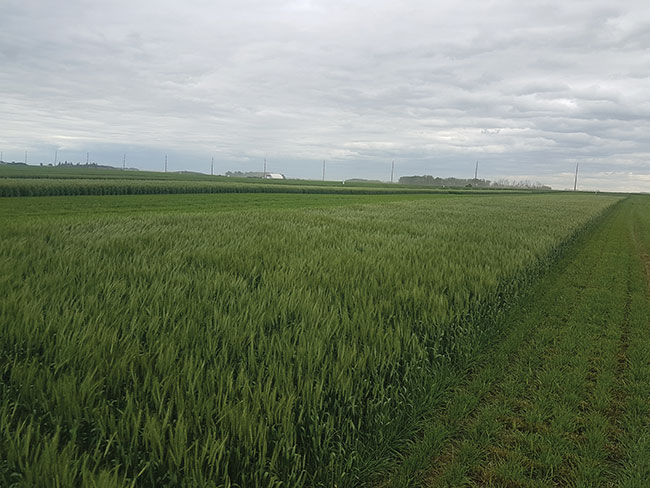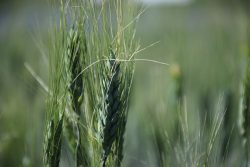
Features
Seed Treatment
Farm-saved seed/Certified seed matchup
A Saskatchewan study compares performance.
September 6, 2020 By Carolyn King
 A study comparing farm-saved and certified wheat seed is taking place in Yorkton (shown here) and seven other sites across Saskatchewan. Photo courtesy of East Central Research Foundation/Parkland College.
A study comparing farm-saved and certified wheat seed is taking place in Yorkton (shown here) and seven other sites across Saskatchewan. Photo courtesy of East Central Research Foundation/Parkland College. Can farm-saved seed perform as well as the same variety of Certified seed? A three-year study aims to answer this question for popular wheat varieties grown under Saskatchewan conditions.
“There were questions being raised by producers about the relative performance of Certified and farm-saved wheat seed, and this is an area that hasn’t been well documented in the past. So we were interested in providing more information for producers; we’ve got a mandate that supports research that contributes to profitable wheat production for our farmers,” explains Harvey Brooks, general manager of the Saskatchewan Wheat Development Commission (Sask Wheat).
“Many farmers choose to save and clean their seed to reduce costs. We want to make sure that they are doing that with the full information set.”
Through joint research project planning meetings with Saskatchewan’s Agri-ARM applied research organizations and crop commissions, this issue was identified by Sask Wheat as an area of interest to study further. The Agri-ARM network took up the challenge of designing and implementing the study at the eight Agri-ARM sites.
“It wasn’t an easy request; I found that little research had been done to compare yields between Certified and farm-saved seed for wheat in Western Canada. But I think we came up with a way to get a reasonable comparison,” says Mike Hall, research co-ordinator for Parkland College and the East Central Research Foundation at Yorkton.
Hall is leading this Sask Wheat-funded study, which started in 2019. He is working with his counterparts in the other Agri-ARM organizations to carry out the work at the eight sites.
Brooks notes, “The study is comparing the vigour and the yield performance of farm-saved seed to Certified seed, and it is also determining if seed treatment improves the vigour and yield potential for farm-saved seed. Also, because the research is being performed at the eight Agri-ARM sites across the province, the results should give producers data that is applicable to their local conditions. We’re hoping that the findings will be another aid to producers as they plan their crops.”
Weighing the options
Farm-saved seed is much more widely used than Certified seed for cereal production in Western Canada. For example, a 2018 report, called Canada’s Seed System: Economic Impact Assessment and Risk Analysis, estimates that only about 20 per cent of commercial spring wheat acres in Western Canada were planted with Certified seed from 2012 to 2014.
Hall suspects that the current Certified percentage might be somewhat higher at present in Saskatchewan, based on his personal observation that quite a few producers are growing midge-tolerant wheat in 2020. “Producers buying midge-tolerant wheat seed must sign an agreement that limits the use of farm-saved seed to one generation past Certified seed [to help sustain the effectiveness of the midge resistance gene],” he explains. “So growing more acres of midge-tolerant seed would mean less opportunity to save seed.”
Producers consider various factors when choosing whether to use Certified or farm-saved seed in a field. “I think the biggest reasons why producers use farm-saved seed are that it’s cheaper and it’s their own seed [so they are familiar with it]. Even though there are costs associated with getting your farm-saved seed cleaned, it is still cheaper than Certified,” Hall says. Certified seed costs more because of the extra steps and fees involved in meeting the strict requirements for certification.
“Producers using Certified seed benefit from the introduction of better genetics to the farm. Certified seed is valuable because it is ‘true to type,’ meaning it has retained all the genetic benefits developed by the breeder. This helps with quality assurance for the end-users, which is of increasing importance as the industry moves toward a value chain model. In addition, to be Certified, seed must meet high standards of germination and freedom from impurities, which are determined by an officially recognized third-party agency,” he says.
“[Furthermore, Certified seed purchases help fund variety development.] I think most producers realize it is important to support a system that ensures the development of new varieties to keep Canadian wheat producers globally competitive. However, exactly how this support should be provided is currently under debate.”
Twenty-four comparisons per year
At each of the eight Agri-ARM sites, the study is comparing three different seedlots of farm-saved seed against three different Certified seedlots of the same variety. So each year, the study makes a total of 24 comparisons.
The Certified and farm-saved seedlots of each variety are generally obtained from producers local to each of the sites, which are at Yorkton, Redvers, Indian Head, Swift Current, Scott, Outlook, Prince Albert and Melfort.
The variety comparisons differ between sites depending on what is locally popular with growers. For instance, a site might have all three of the comparisons using different seedlots of the same variety or it might have a different variety for each of the three comparisons.
In 2019, the farm-saved seed used in the study was usually two to three years past Certified. Most of the varieties were hard red spring wheats, but some sites had some durum varieties. AAC Brandon was the most popular; this hard red spring variety was used in 13 of the 24 comparisons.
The farm-saved seedlots in the study are in the same condition as the farm-saved seed the producers plant in their own fields, so the seed is cleaned before seeding. All the study’s seedlots are tested for germination, vigour and five common seed-borne pathogens.
All the farm-saved/Certified comparisons are done with bare seed and with treated seed. The specific product used for the seed treatment depends on the site.

In the trial, both farm-saved seed and certified seed had the same average yield and protein.
Key findings from 2019
“In 2019, seed quality was excellent for both the Certified and farm-saved seedlots. Seed vigour averaged 93 per cent across the 24 comparisons for both farm-saved and Certified seed,” Hall says.
“Seed-borne diseases were generally low for both Certified and farm-saved seed, although the disease levels tended to be somewhat more variable on the farm-saved seed. We did have one seedlot of farm-saved seed with total Fusarium levels beyond acceptable levels.”
He notes, “At all the sites, we had good growing conditions and good harvest conditions and not a lot of diseases on the seeds in 2019 and also in 2018, when the seed for 2019 was produced. Those conditions contribute to producing quality seed.”
In most cases, yield and grain protein did not significantly differ between the Certified and farm-saved seedlots in 2019. “This is not surprising, given that the seed quality was very good for both seed types in almost every case,” Hall says.
“Averaged across all 24 comparisons, both farm-saved seed and Certified seed had a yield of 64.9 bushels per acre and 14.2 per cent protein. So we had the exact same average yield and protein for the two types.”
He adds, “Even that one seedlot with a high level of seed-borne disease had pretty decent yields, probably in part because we were seeding into very good conditions. If you have a high amount of seed-borne disease and you’re seeding into cold, wet conditions – so the seed is not germinating or growing very fast – then certain diseases really start to go after the roots.”
In most instances, the seed treatment did not affect emergence, seedling vigour, yield or protein in the farm-saved seed or the Certified seed. He says, “If you have good quality seed and low disease in the field and very good growing conditions, it can be hard to see a benefit from seed treatment, in my opinion.”
Take-home messages from Year 1
“In 2019, most of the farm-saved seed used in this study was two to three years removed from Certified, and its use didn’t seem to have any detrimental effects on wheat yield or quality compared to the Certified seed. This supports the strategy of growing farm-saved seed for a couple years and then buying Certified seed to introduce better genetics or seed that is true to type,” Hall says.
“These results do not mean that there is no value in purchasing Certified seed. They only mean there were no production risks from growing farm-saved wheat seed rather than Certified wheat seed in Saskatchewan in 2019.”
He notes, “Over the course of the study, we may see Certified seed outperform farm-saved seed under adverse growing conditions. We’ll have to wait and see.” Certified seed production follows strict production procedures and is tested to ensure that seed quality remains high no matter what growing conditions occur.
Hall recommends that producers have their farm-saved seed tested for vigour and seed-borne diseases, along with the usual germination test, especially if growing conditions are not very good. He explains that a vigour test gives a better indication of crop emergence and seedling vigour than the standard germination test, particularly in a cold, wet spring. And a test for seed-borne diseases can indicate whether it would be advisable to use a different seedlot or apply a seed treatment.
The study is continuing at all eight locations in 2020. Hall says, “The protocols are all the same, but the seedlots and varieties compared are different. By the end of the study in 2021, we should have 72 comparisons between farm-saved and Certified seed, with a seedlot never used in the study more than once.”